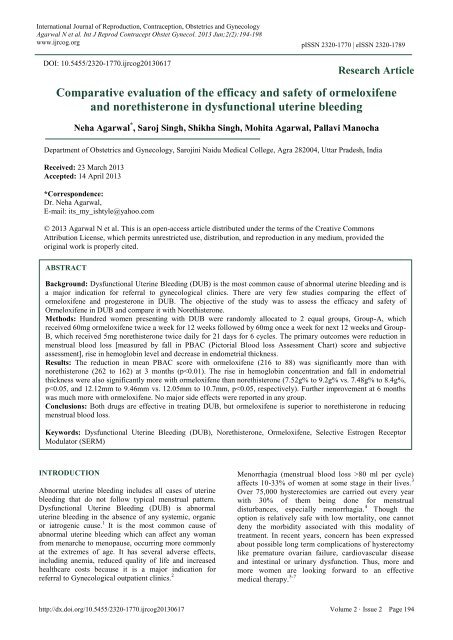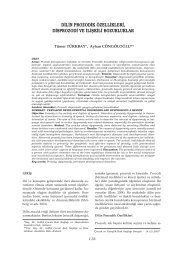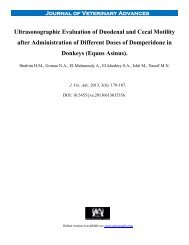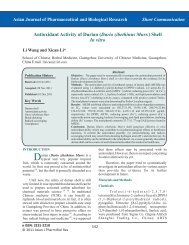Research Article - eJManager.com
Research Article - eJManager.com
Research Article - eJManager.com
Create successful ePaper yourself
Turn your PDF publications into a flip-book with our unique Google optimized e-Paper software.
International Journal of Reproduction, Contraception, Obstetrics and Gynecology<br />
Agarwal N et al. Int J Reprod Contracept Obstet Gynecol. 2013 Jun;2(2):194-198<br />
www.ijrcog.org pISSN 2320-1770 | eISSN 2320-1789<br />
DOI: 10.5455/2320-1770.ijrcog20130617<br />
<strong>Research</strong> <strong>Article</strong><br />
Comparative evaluation of the efficacy and safety of ormeloxifene<br />
and norethisterone in dysfunctional uterine bleeding<br />
Neha Agarwal * , Saroj Singh, Shikha Singh, Mohita Agarwal, Pallavi Manocha<br />
Department of Obstetrics and Gynecology, Sarojini Naidu Medical College, Agra 282004, Uttar Pradesh, India<br />
Received: 23 March 2013<br />
Accepted: 14 April 2013<br />
*Correspondence:<br />
Dr. Neha Agarwal,<br />
E-mail: its_my_ishtyle@yahoo.<strong>com</strong><br />
© 2013 Agarwal N et al. This is an open-access article distributed under the terms of the Creative Commons<br />
Attribution License, which permits unrestricted use, distribution, and reproduction in any medium, provided the<br />
original work is properly cited.<br />
ABSTRACT<br />
Background: Dysfunctional Uterine Bleeding (DUB) is the most <strong>com</strong>mon cause of abnormal uterine bleeding and is<br />
a major indication for referral to gynecological clinics. There are very few studies <strong>com</strong>paring the effect of<br />
ormeloxifene and progesterone in DUB. The objective of the study was to assess the efficacy and safety of<br />
Ormeloxifene in DUB and <strong>com</strong>pare it with Norethisterone.<br />
Methods: Hundred women presenting with DUB were randomly allocated to 2 equal groups, Group-A, which<br />
received 60mg ormeloxifene twice a week for 12 weeks followed by 60mg once a week for next 12 weeks and Group-<br />
B, which received 5mg norethisterone twice daily for 21 days for 6 cycles. The primary out<strong>com</strong>es were reduction in<br />
menstrual blood loss [measured by fall in PBAC (Pictorial Blood loss Assessment Chart) score and subjective<br />
assessment], rise in hemoglobin level and decrease in endometrial thickness.<br />
Results: The reduction in mean PBAC score with ormeloxifene (216 to 88) was significantly more than with<br />
norethisterone (262 to 162) at 3 months (p
Agarwal N et al. Int J Reprod Contracept Obstet Gynecol. 2013 Jun;2(2):194-198<br />
Antifibrinolytics, non-steroidal anti-inflammatory drugs<br />
(NSAIDs), progesterones, <strong>com</strong>bined estrogen and<br />
progesterones, danazol, gonadotrophin releasing hormone<br />
analogues and levonorgesterol-releasing intrauterine<br />
system have all been used with different results.<br />
Norethisterone, a progestogen, is <strong>com</strong>monly used for<br />
this purpose but being a hormonal drug, it is associated<br />
with side effects such as stroke, heart disease, breast<br />
cancer, dementia, fluid retention, breakthrough bleeding,<br />
spotting etc.<br />
Ormeloxifene, a third generation Selective Estrogen<br />
Receptor Modulator (SERM) selectively acts on estrogen<br />
receptors as agonist and antagonist in different<br />
reproductive tissues. 8 It has anti-estrogenic action on<br />
endometrium and breast and estrogenic action on bones,<br />
vagina, liver, cardiovascular and central nervous system.<br />
The ideal therapy in perimenopausal women is one that<br />
has no uterine stimulation, prevents bone loss, has no risk<br />
of breast cancer, has a positive effect on lipids and<br />
cardiovascular system and maintains cognitive function<br />
of brain. SERM in general and ormeloxifene in particular<br />
satisfy these requirements. 9,10<br />
Unlike progesterone, ormeloxifene does not produce<br />
spotting, breakthrough bleeding or menorrhagia. Clinical<br />
studies have shown the effectiveness of ormeloxifene in<br />
DUB, but there are very few studies <strong>com</strong>paring the effect<br />
of ormeloxifene and progesterone in DUB.<br />
The aim of this study was to assess the efficacy and<br />
safety of ormeloxifene in DUB and to <strong>com</strong>pare it with<br />
norethisterone.<br />
METHODS<br />
This is a prospective <strong>com</strong>parative study conducted in the<br />
Department of Obstetrics and Gynecology, S.N Medical<br />
College, Agra, in which 100 women presenting with<br />
abnormal uterine bleeding without any organic, systemic<br />
or iatrogenic cause were recruited. Ethical approval was<br />
taken from the institutional ethical <strong>com</strong>mittee. Exclusion<br />
criteria were pregnancy, bleeding disorders, medical<br />
disorders- liver dysfunction, heart disease, migraine,<br />
stroke, renal disease, hypo/hyperthyroidism, and lactating<br />
women in first 6 months of post natal period.<br />
Informed consent was taken. A detailed history and<br />
examination was done. DUB is a diagnosis of exclusion.<br />
Investigations were done to rule out any other possible<br />
cause for abnormal uterine bleeding. These were<br />
<strong>com</strong>plete blood cell count including hemoglobin (Hb)<br />
level, pregnancy test, thyroid stimulating hormone,<br />
coagulation profile, pap smear, pelvic ultrasound (to<br />
measure endometrial thickness and rule out any pelvic<br />
pathology) and endometrial sampling for<br />
histopathological assessment.<br />
The cases were asked to maintain a menstrual diary<br />
recording the days of bleeding, number of sanitary pads<br />
used, degree of soiling of each pad, number and size of<br />
clots passed, episodes of bleeding, the presence of<br />
menstrual cramps and other symptoms experienced. A<br />
Pictorial Blood loss Assessment Chart (PBAC) Scoring<br />
was done accordingly to assess menstrual blood loss<br />
(Table 1). PBAC is a simple and less time consuming<br />
procedure for objective assessment of menstrual blood<br />
loss, which does not require collection of sanitary<br />
products and avoids costly chemical analysis. A PBAC<br />
score ≥ 100 indicates a menstrual blood loss ≥ 80ml and<br />
is considered diagnostic for menorrhagia. 11<br />
Pads<br />
Clots<br />
Table 1: PBAC Scoring. 11<br />
Lightly soiled 1<br />
Moderately soiled 5<br />
Saturated 20<br />
Small (smaller than a rupee coin) 1<br />
Large (larger than a rupee coin) 5<br />
The women were randomly allocated to 2 groups of 50<br />
each. Group A was given Ormeloxifene tablet 60mg twice<br />
a week for 12 weeks followed by 60mg once a week for<br />
next 12 weeks. Group B was given Norethisterone tablet<br />
5mg twice a day for 21 days followed by 7 days<br />
withdrawal for 6 cycles. Follow up was done at 1, 3 and 6<br />
months. At each visit a detailed menstrual history was<br />
taken, PBAC score was calculated and hemoglobin<br />
concentration and endometrial thickness were measured.<br />
Subjective improvement and any side effects experienced<br />
were also noted.<br />
The primary out<strong>com</strong>e measures were reduction in<br />
amount of menstrual blood loss (assessed by fall in<br />
PBAC score and patient’s subjective assessment), rise in<br />
hemoglobin concentration and decrease in endometrial<br />
thickness in proliferative phase on transvaginal<br />
ultrasound. Secondary out<strong>com</strong>e measures were the side<br />
effects.<br />
All continuous efficacy parameters were presented as<br />
Mean ± Standard Deviation and were analyzed using the<br />
student t test. Statistical significance was taken at p ≤<br />
0.05.<br />
RESULTS<br />
The cases in both the groups matched well with regards<br />
to mean age, parity, socioeconomic status and duration<br />
of symptoms. The pretreatment mean PBAC score,<br />
mean hemoglobin level and mean endometrial thickness<br />
were also <strong>com</strong>parable in both the groups (Table 2). The<br />
most <strong>com</strong>mon presenting <strong>com</strong>plaint was menorrhagia<br />
(60% in group A and 64% in group B). Proliferative<br />
endometrium was the most <strong>com</strong>mon endometrial pattern<br />
in both groups followed by cystic glandular hyperplasia<br />
(Table 3).<br />
International Journal of Reproduction, Contraception, Obstetrics and Gynecology Volume 2 · Issue 2 Page 195
Agarwal N et al. Int J Reprod Contracept Obstet Gynecol. 2013 Jun;2(2):194-198<br />
Table 2: Clinical profile and parameters before starting therapy.<br />
Clinical parameters<br />
Group A<br />
Group B<br />
(Ormeloxifene) n=50 (Norethisterone) n=50<br />
p value<br />
Mean age (years) 38.3 39.1 > 0.05<br />
Mean parity 3 3 > 0.05<br />
Socioeconomic status III III > 0.05<br />
Mean duration of symptoms (months) 9.4 9.6 > 0.05<br />
Mean PBAC score 216 232 > 0.05<br />
Mean Hb level (gm%) 7.52 7.48 > 0.05<br />
Mean endometrial thickness (mm) 12.12 12.05 > 0.05<br />
Table 3: Endometrial patterns on histopathology.<br />
Endometrial patterns<br />
Group A (Ormeloxifene) n=50 Group B (Norethisterone) n=50<br />
No. Percentage (%) No. Percentage (%)<br />
Proliferative 19 38 18 36<br />
Cystic glandular hyperplasia 17 34 17 34<br />
Secretory 10 20 12 24<br />
Irregular ripening 3 6 2 4<br />
Irregular shedding 1 2 1 2<br />
Total 50 100 50 100<br />
Table 4: Comparison of Ormeloxifene and Norethisterone.<br />
Out<strong>com</strong>e measures<br />
Pretreatment<br />
(n=50)<br />
After 3 months of<br />
therapy (n=50)<br />
Mean PBAC score<br />
Ormeloxifene 216 88 84<br />
Norethisterone 232 162 170<br />
Mean Hb level (gm%)<br />
Ormeloxifene 7.52 9.2 10.4<br />
Norethisterone 7.48 8.4 8.6<br />
Mean endometrial thickness (mm)<br />
Ormeloxifene 12.12 9.46 8.4<br />
Norethisterone 12.05 10.7 9.8<br />
After 6 months of<br />
therapy (n=50)<br />
p value<br />
Agarwal N et al. Int J Reprod Contracept Obstet Gynecol. 2013 Jun;2(2):194-198<br />
months and further reduced to 8.4mm after 6 months of<br />
therapy with ormeloxifene (p
Agarwal N et al. Int J Reprod Contracept Obstet Gynecol. 2013 Jun;2(2):194-198<br />
sanitary napkins used after 6 months of ormeloxifene<br />
therapy.<br />
Amenorrhea / hypomenorrhea is a <strong>com</strong>mon symptom<br />
seen with ormeloxifene in different studies with a wide<br />
range of 8% to 63%. 1,7,16 It is more <strong>com</strong>mon in<br />
perimenopausal women. However, with proper<br />
counseling, the women find it a desirable symptom at this<br />
age.<br />
In the present study, the most <strong>com</strong>mon endometrial<br />
pattern was proliferative followed by cystic glandular<br />
hyperplasia and secretory endometrium. However,<br />
Kriplani et al 14 found secretory endometrium to be the<br />
most <strong>com</strong>mon pattern followed by proliferative and<br />
simple hyperplasia without atypia.<br />
CONCLUSIONS<br />
Dysfunctional uterine bleeding is a <strong>com</strong>mon<br />
gynecological problem. Majority of the patients respond<br />
well to medical therapy. Both ormeloxifene and<br />
progesterone (norethisterone) are effective in treating<br />
these cases as studied by reduction in PBAC score,<br />
subjective improvement, rise in hemoglobin level and<br />
reduction in endometrial thickness. However, the effect is<br />
significantly more with ormeloxifene. Thus, ormeloxifene<br />
was found to be superior to norethisterone in reducing<br />
menstrual loss. There are no major side effects or<br />
<strong>com</strong>plications with either of the drugs. A convenient dose<br />
schedule and cost effectiveness of ormeloxifene further<br />
increases its <strong>com</strong>pliance.<br />
Funding: No funding sources<br />
Competing interests: There are no <strong>com</strong>peting interests to<br />
declare<br />
Ethical approval: The study was approved by the<br />
institutional ethics <strong>com</strong>mittee<br />
REFERENCES<br />
1. Dadhich S, Agarwal S, Soni M, Jain R. Role of<br />
Ormeloxifene in medical management of<br />
dysfunctional uterine bleeding. Asian J Obstet<br />
Gynaecol Practice 2012;6:28-31.<br />
2. Frick KD, Clark MA, Steinwachs DM, Langenberg<br />
P, Stovall D, Munro MG, et al. STOP-DUB<br />
<strong>Research</strong> Group. Financial and quality-of-life<br />
burden of dysfunctional uterine bleeding among<br />
women agreeing to obtain surgical treatment.<br />
Womens Health Issues 2009;19:70-8.<br />
3. Hallberg L, Hodgahl AM, Nilsson L, Rybo G.<br />
Menstrual blood loss- a population study Variation<br />
at different ages and attempts to define normality.<br />
Acta Obstet Gynecol Scand 1966;45:320-51.<br />
4. Coulter A, McPherson K, Vessey M. Do British<br />
women undergo too many or too few hysterectomies?<br />
Soc Sci Med 1988;27:987-94.<br />
5. Coulter A, Kelland J, Peto V, Rees MCP. Treating<br />
menorrhagia in primary care. An overview of drug<br />
trials and a survey of prescribing practice. Int J Tech<br />
Assess Health Care 1995;11:456-71.<br />
6. Winsor SHM, Fisher S, Hahn PM, Reid RL.<br />
Retrospective evaluation of the long term out<strong>com</strong>es<br />
following conservative management of menorrhagia<br />
in ovulatory women. J Soc Obstet Gynecol Can<br />
1999;2:155-63.<br />
7. Bhattacharyya TK, Banerji A. Efficacy of a selective<br />
estrogen receptor modulator: ‘ormeloxifene’ in<br />
management of dysfunctional uterine bleeding. South<br />
Asian Federation of Obstetrics and Gynaecology<br />
2010;2:207-11.<br />
8. Shelly W, Draper MW, Krishnan V, Wong M, Jaffe<br />
RB. Selective estrogen receptor modulators: an<br />
update on recent clinical findings. Obstet Gynecol<br />
Surv 2008;63:163-81.<br />
9. Singh MM. Centchroman, a selective estrogen<br />
receptor modulator, as a contraceptive and for the<br />
management of hormone-related clinical disorders.<br />
Med Res Rev 2001;21:302-47.<br />
10. Osborne CK, Zhao H, Fuqua SA. Selective estrogen<br />
receptor modulators: structure, function, and clinical<br />
use. J Clin Oncol 2000;18:3172-86.<br />
11. Higham JM, O’Brien PMS, Shaw RW. Assessment<br />
of menstrual blood loss using a pictorial chart. Br J<br />
Obstet Gynaecol 1990;97:734-9.<br />
12. Livingstone M, Fraser IS. Mechanisms of abnormal<br />
uterine bleeding. Hum Reprod Update 2002;8:60-7.<br />
13. Shravage J, Mekhala D, Bellad MB, Ganachari MS,<br />
Dhumale HA. Ormeloxifene versus<br />
Medroxyprogesterone Acetate (MPA) in the<br />
treatment of Dysfunctional Uterine Bleeding: A<br />
double-blind randomized controlled trial. JSAFOG<br />
2011;3:21-4.<br />
14. Kriplani A, Kulshrestha V, Agarwal N. Efficacy and<br />
safety of ormeloxifene in management of<br />
menorrhagia: a pilot study. J Obstet Gynaecol Res<br />
2009;35:746-52.<br />
15. BS D, Nanda SK. The role of Sevista in the<br />
management of Dysfunctional Uterine Bleeding. J<br />
Clin Diagn Res 2013;7:132-4.<br />
16. Biswas SC, Saha SK, Bag TS, GhoshRoy SC, Roy<br />
AC, Kabiraj SP. Ormeloxifene A Selective Estrogen<br />
Receptor Modulator, for treatment of dysfunctional<br />
menorrhagia. J Obstet Gynecol 2004;54:56-9.<br />
DOI: 10.5455/2320-1770.ijrcog20130617<br />
Cite this article as: Agarwal N, Singh S, Singh S,<br />
Agarwal M, Manocha P. Comparative evaluation of<br />
the efficacy and safety of ormeloxifene and<br />
norethisterone in dysfunctional uterine bleeding. Int<br />
J Reprod Contracept Obstet Gynecol 2013;2:194-8.<br />
International Journal of Reproduction, Contraception, Obstetrics and Gynecology Volume 2 · Issue 2 Page 198

















